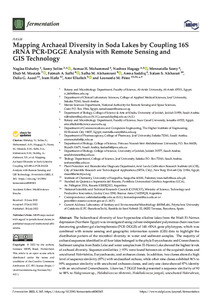Por favor, use este identificador para citar o enlazar este ítem:
https://repositorio.uca.edu.ar/handle/123456789/14809| Título: | Mapping archaeal diversity in soda lakes by coupling 16S rRNA PCR-DGGE analysis with remote sensing and GIS technology | Autor: | Elshafey, Naglaa Selim, Samy Mohammed, Asmaa H. Hagagy, Nashwa Samy, Mennatalla Mostafa, Ehab M. Safhi, Fatmah A. Saddiq, Amna Alsharari, Salam S. Aseel, Dalia G. Hafiz, Iram Elkelish, Amr Pérez, Leonardo Martín |
Palabras clave: | HALOARQUEAS; BIOTECNOLOGIA; BIODIVERSIDAD | Fecha de publicación: | 2022 | Editorial: | MDPI | Cita: | Elshafey, N., et al. Mapping archaeal diversity in soda lakes by coupling 16S rRNA PCR-DGGE analysis with remote sensing and GIS technology [en línea]. Fermentation. 2022, 8(8), 365, doi:10.3390/fermentation8080365 Disponible en: https://repositorio.uca.edu.ar/handle/123456789/14809 | Resumen: | Abstract: The haloarchaeal diversity of four hypersaline alkaline lakes from the Wadi El-Natrun depression (Northern Egypt) was investigated using culture-independent polymerase chain reaction-denaturing gradient gel electrophoresis (PCR-DGGE) of 16S rRNA gene phylotypes, which was combined with remote sensing and geographic information system (GIS) data to highlight the distribution pattern of the microbial diversity in water and sediment samples. The majority of archaeal sequences identified in all four lakes belonged to the phyla Euryarchaeota and Crenarchaeota. Sediment samples from Beida Lake and water samples from El-Hamra Lake showed the highest levels of archaeal diversity. Sequence similarities ≥ 95% were found between six of the acquired clones and uncultured Halorhabdus, Euryarchaeota, and archaeon clones. In addition, two clones shared a high level of sequence similarity (97%) with unclassified archaea, while other nine clones exhibited 96% to 99% sequence similarity with uncultured archaeon clones, and only one clone showed 97% identity with an uncultured Crenarchaeota. Likewise, 7 DGGE bands presented a sequence similarity of 90 to 98% to Halogranum sp., Halalkalicoccus tibetensis, Halalkalicoccus jeotgali, uncultured Halorubrum, Halobacteriaceae sp., or uncultured haloarchaeon. In conclusion, while the variety of alkaliphilic haloarchaea in the examined soda lakes was restricted, the possibility of uncovering novel species for biotechnological applications from these extreme habitats remains promising. | URI: | https://repositorio.uca.edu.ar/handle/123456789/14809 | ISSN: | 2311-5637 | Disciplina: | INGENIERIA AMBIENTAL | DOI: | 10.3390/ fermentation8080365 | Derechos: | Acceso abierto | Fuente: | Fermentation. 2022, 8(8), 365 |
| Aparece en las colecciones: | Artículos |
Ficheros en este ítem:
| Fichero | Descripción | Tamaño | Formato | |
|---|---|---|---|---|
| mapping-archaeal-diversity.pdf | 6,79 MB | Adobe PDF |  Visualizar/Abrir |
Visualizaciones de página(s)
51
comprobado en 27-abr-2024
Descarga(s)
34
comprobado en 27-abr-2024
Google ScholarTM
Ver en Google Scholar
Altmetric
Altmetric
Este ítem está sujeto a una Licencia Creative Commons

